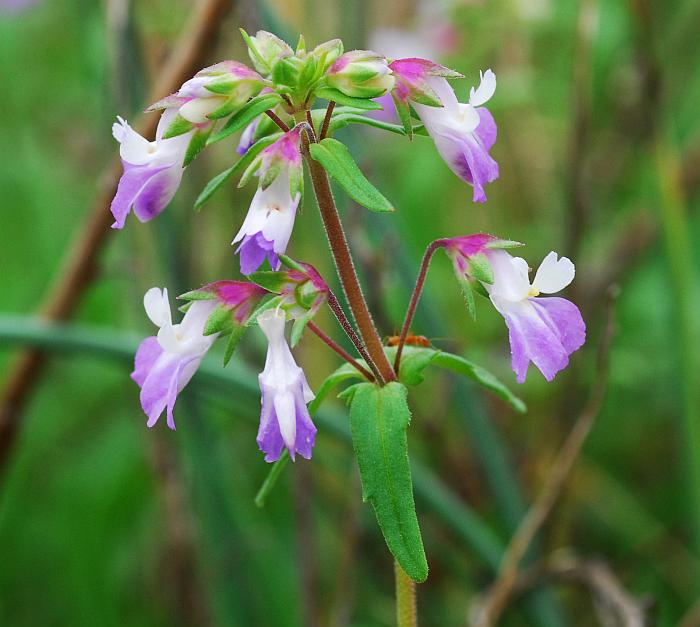Collinsia violacea Nutt.
Violet Collinsia

Native
CC = 8
CW = 5
MOC = 24
© SRTurner
Collinsia violacea Nutt.Violet Collinsia | |
 |
Native CC = 8 CW = 5 MOC = 24 |
© SRTurner |
|
Family - Plantaginaceae Habit - Taprooted annual forb. Stem - Erect, to 30 cm, minutely glandular-pubescent, especially toward the tips, the hairs not in lines.
Leaves - Opposite, simple, unlobed, shallowly few-toothed, nearly glabrous. Upper leaves sessile and somewhat clasping, oblong-lanceolate to elliptic, broadest well above the base, often near the midpoint. Lower leaves short-petiolate, ovate.
Inflorescence - Terminal racemes, appearing axillary due to presence of leafy bracts, the flowers on stalks 6-15 mm long, opposite or whorled at nodes.
Calyx - Actinomorphic, 5-7 mm long, bell-shaped, 5-lobed to below midpoint, mostly glabrous.
Corollas - Corollas zygomorphic, bilabiate, 9-13 mm long, nearly glabrous, upper lip white, 2-lobed, lower lip purplish, 3-lobed, upper lip noticeably shorter than lower. Corolla lobes noticeably notched at apex.
Fruits - Globose capsules 4-5 mm long, glabrous. Seeds 6-12 per fruit, 1.2-1.6 mm long
Flowering - April - June. Habitat - Glades, dry upland forests and prairies, sand prairies, railroads, roadsides. Origin - Native to the U.S. Lookalikes - Collinsia verna. Other info. - This small but attractive species is found across a relatively small area of the central U.S., roughly centered at the intersection of Missouri, Arkansas, Oklahoma, and Kansas. Its range in Missouri is mostly in the southwest, with populations also found in the Bootheel region. A close relative of the more common blue-eyed Mary, it can be distinguished from that species by having more purplish lower corolla lips. However, since occasional plants of the common blue-eyed Mary (Collinsia verna) will also have purple corollas, this difference alone does not provide an unambiguous assignment. More definitive characters are notched petal lobes, upper corolla lips which are noticeably shorter than the lower lips, and leaves which are widest well above their bases. In Steyermark's time, C. violacea was frequently found in dense, showy populations along roadsides in southwestern Missouri. Photographs taken at Sand Prairie Conservation Area, Scott County, MO, 4-21-2013, 4-17-2015, and 5-6-2020 (SRTurner). |